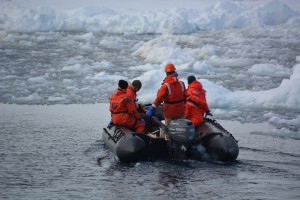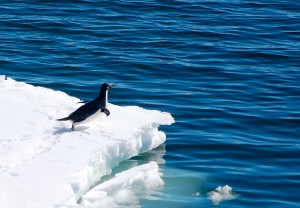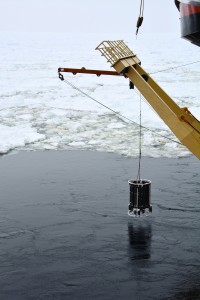11 August 2015
WASHINGTON, D.C. – Nutrient-rich water from melting Antarctic glaciers nourishes the ocean food chain, creating feeding “hot spots” in large gaps in the sea ice, according to a new study.
New research finds that iron stored in the region’s glaciers is being shuttled by melting water to open areas of the ocean, called polynyas, where it stimulates growth of phytoplankton, ocean algae that form the base of the marine food chain. Krill and fish thrive on phytoplankton, and these smaller animals support penguins, seals and whales that feed and breed in the polynyas that ring the Antarctic coast, according to new research.
Watch Kevin Arrigo describe his research on Antarctica’s hot-spots, the icy world of polynyas.
Credit: Stanford University
Increased melting of Antarctic glaciers in the coming decades, which scientists say could occur as a result of climate change, could cause a spike in the amount of iron in the polynyas, according to the new study. The increased iron could boost phytoplankton in these open areas, potentially providing more food for the entire food chain, suggests the new study accepted for publication in Journal of Geophysical Research: Oceans, an American Geophysical Union journal.
“These coastal polynyas are sensitive to inputs from adjacent glaciers, and these glaciers are probably going to accelerate their melting in the future, which is certainly going to have implications for these polynyas,” said Kevin Arrigo, a biological oceanographer with the Department of Earth System Science at Stanford University in California, and lead author of the new study.
“Coastal Antarctica is likely to become a more productive place in the future,” Arrigo said.

Scientists and ASC Marine Technicians head out on the zodiac to collect ice samples near the West Antarctic Peninsula. Pictured from left to right: Kevin Arrigo (Stanford), John Betz (ASC Marine Lab), Tom Sigmond (ASC Marine Lab), Yussi Delgado (Monash Univeristy), John Butterfield (Stanford).
Credit: Hannah Joy-Warren
Polynyas are created during the summer when winds whip off the Antarctic Ice Sheet, pushing floating sea ice away from the shore. These open areas of water, which range from the size of San Diego to an area equal to the Great Lakes, are hot spots for phytoplankton and, in turn, the entire ocean food chain, according to Arrigo.
“When you look at satellite images of ocean color, these areas just light up [green] compared to the [blue] waters around them,” he said.
The new research by Arrigo and his team suggests that the amount of water leaving melting Antarctic glaciers is the largest driver behind the abundance of phytoplankton in the polynyas, not sunlight or temperature as scientists had previously thought. Larger amounts of water coming off the glaciers carry more iron into the polynyas, which should simulate more phytoplankton growth, according to the new study.
This new information about phytoplankton growth in polynyas, based on satellite data, gives scientists greater insight into how the Antarctic marine food web works and how it could be affected by climate change, according to the study’s authors. Arrigo noted that although climate change could increase the amount of iron in the polynyas, any positive effects of the additional iron may be offset by other climate change-driven environmental shifts. He added that most marine organisms will be negatively affected by global increases in ocean temperatures and acidification that are expected to happen as a result of climate change.
The new research could also shed light on how carbon is stored in the ocean, Arrigo said. The new study suggests that phytoplankton in the polynyas could be responsible for pulling in large amounts of carbon dioxide from the atmosphere through photosynthesis. The polynyas could be acting as storage sites for carbon released into the atmosphere by fossil fuel burning, according to the new study.
“These polynyas appear to be disproportionately important, for their size, as sinks of carbon. And the reality is that they really are not included in anyone’s carbon budget,” said Arrigo.

Adélie penguin (Pygoscelis adeliae) preparing to dive into the water in the Ross Sea, Antarctica.
Credit: Hannah Joy-Warren
Measuring polynyas, phytoplankton
The researchers used satellite images from 1997 to 2014 to calculate the amount of phytoplankton growing in 46 polynyas that ring the coast of Antarctica. They compared these numbers with data describing the size of the polynyas, the melt rate of nearby glaciers, and the width of the local seafloor in order to identify which environmental characteristics could be linked to phytoplankton growth.
The study found that phytoplankton were most abundant in polynyas near glaciers pumping out large amounts of water. The authors believe water from the glaciers acts as a food delivery system for the algae, bringing iron right to the phytoplankton’s doorstep.
Phytoplankton need iron to grow, but the nutrient is scarce in many Antarctic coastal waters. Glaciers, however, accumulate iron from sediments they pick up as they grind across the land and from dust blown onto the ice. Water coming off the melting glaciers transports the iron into the ocean water, where it makes it way to the polynyas, according to the new research. Large amounts of glacial meltwater and iron mix into polynyas that have formed near glaciers. Polynyas far from glaciers receive less of the glacial meltwater and less iron, according to the new study.

Lowering the CTD (Conductivity Temperature Depth) Rosette into the water just off the coast of the West Antarctic Peninsula.
Credit: Hannah Joy-Warren
While iron-rich water from melting glaciers controls the majority of the phytoplankton growth in polynyas, the study also shows phytoplankton numbers increased in polynyas located over wide, shallow seafloors. Seafloor sediments contain iron from both sunken, dead organisms and dirt from the land. Local water currents moving into shallow waters can stir up iron-rich sediments and carry iron from the shallow seafloors up to the surface, but it is harder for currents to resurrect sediments on deep seafloors, the study suggests.
Higher temperatures also enhanced phytoplankton growth but not nearly as much as Arrigo originally believed. The algae evolved to thrive at low temperatures, and the small differences in temperature between polynyas – from 1 degree to 2 degrees Celsius (34 to 36 degrees Fahrenheit) – does not make a large difference in the amount of phytoplankton, said Arrigo.
The new study helps scientists understand productivity in polynyas, said Peter Sedwick, a chemical oceanographer with Ocean, Earth & Atmospheric Sciences at Old Dominion University in Norfolk, Virginia, who was not associated with the study.
Field measurements are needed to prove the connection between phytoplankton growth in polynyas and iron coming from melting glaciers, he said. This could help shed further light on how phytoplankton productivity – and food for fish, penguins and seals – could change as a result of climate change, Sedwick added.
Click to view more pictures of Kevin Arrigo’s research.
###
The American Geophysical Union is dedicated to advancing the Earth and space sciences for the benefit of humanity through its scholarly publications, conferences, and outreach programs. AGU is a not-for-profit, professional, scientific organization representing more than 60,000 members in 139 countries. Join the conversation on Facebook, Twitter, YouTube, and our other social media channels.
Notes for Journalists
Journalists and public information officers (PIOs) of educational and scientific institutions who have registered with AGU can download a PDF copy of the article by clicking on this link: http://onlinelibrary.wiley.com/doi/10.1002/2015JC010888/full?campaign=wlytk-41855.5282060185
Or, you may order a copy of the final paper by emailing your request to Leigh Cooper at [email protected].
Please provide your name, the name of your publication, and your phone number.
Neither the papers nor this press release is under embargo.
“Environmental controls of marine productivity hot spots around Antarctica”
Authors:
K.R. Arrigo: Department of Earth System Science, Stanford University, Stanford, California, USA;
G.L. van Dijken: Department of Earth System Science, Stanford University, Stanford, California, USA;
A. Strong: Emmett Interdisciplinary Program in Environment and Resources, Stanford University, Stanford, California, USA.
Contact Information for the Authors:
Kevin Arrigo: +1 (650) 723-3599, [email protected]
Leigh Cooper
American Geophysical Union
+1 (202) 777-7324
[email protected]